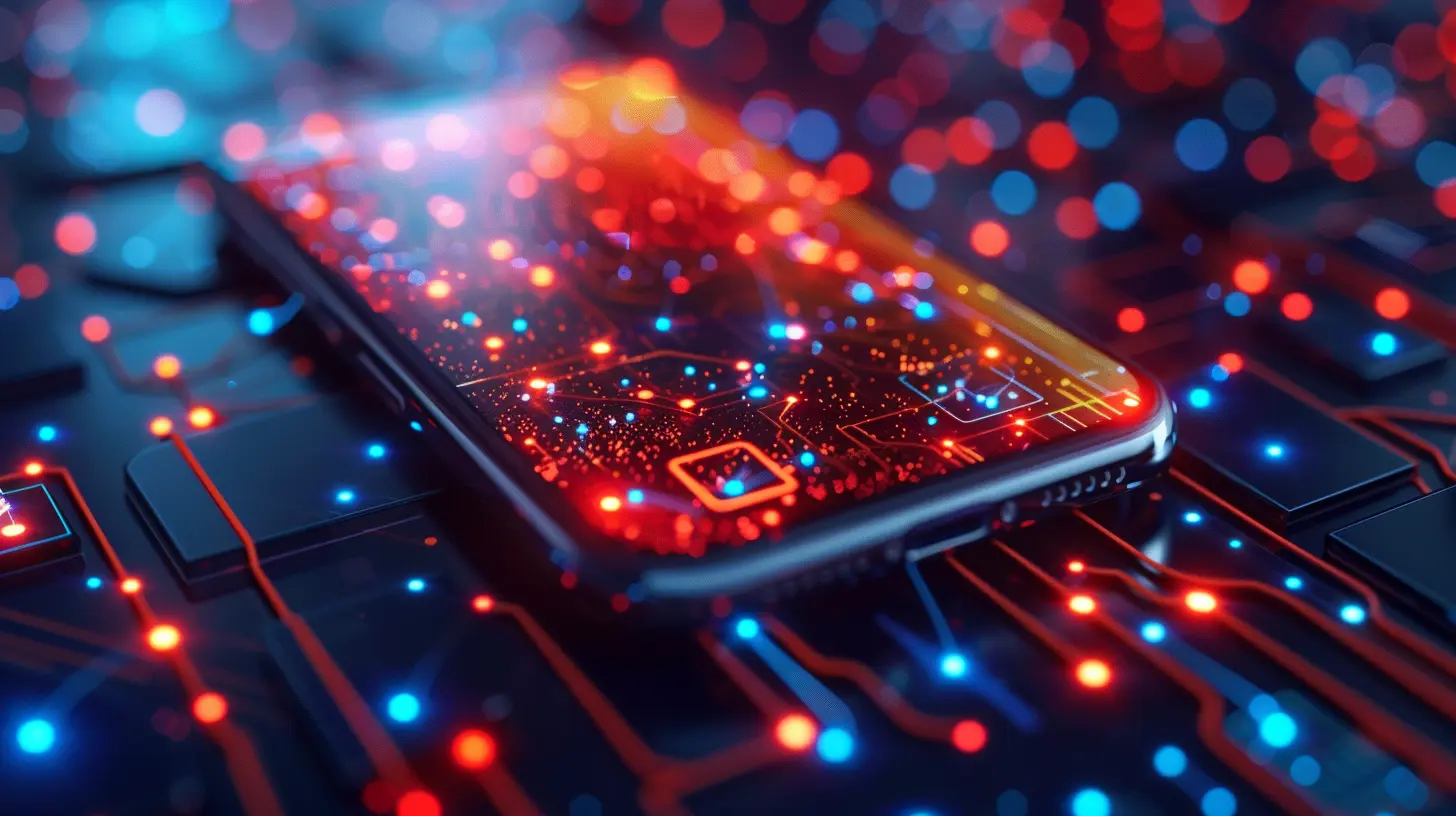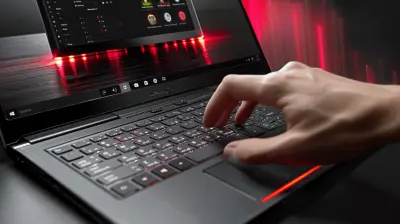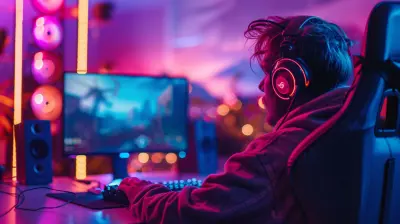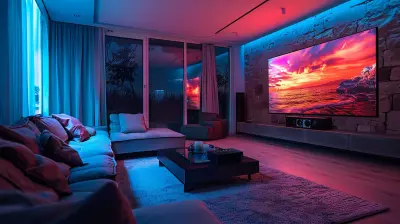From Smartphones to Smart Walls: The Expanding Touchscreen Universe
20 May 2025
Touchscreens have become such a seamless part of our daily lives that we barely give them a second thought. From the moment we wake up and tap our smartphones, to swiping through apps on our tablets, or even interacting with smart displays in our homes, touchscreens are everywhere. But have you ever stopped to consider just how far this technology has come? And more importantly, where it's headed?
In the beginning, touchscreens were a novelty. They were the stuff of sci-fi dreams, something that seemed futuristic and, dare I say, unattainable. Fast forward to today, and they are found in everything from our phones and tablets to our cars and even our kitchen appliances. Now, we're talking about the next big leap: smart walls. Yep, entire walls that you can touch and interact with. Sounds crazy? Well, welcome to the expanding touchscreen universe.

The Rise of Touchscreens: From Niche to Necessity
Touchscreens have been around longer than we might think. The first rudimentary version appeared in the 1960s, but it wasn’t until the early 2000s that they became mainstream. And who can forget that game-changing moment in 2007 when Apple introduced the iPhone? It wasn’t just a phone; it was a revolution. The physical keyboard? Gone. The stylus? Completely unnecessary. It was just you, your finger, and a screen.That was the moment touchscreens became the go-to interface for a huge variety of devices. Suddenly, interacting with electronics felt like second nature. There was no need to learn how to use a device through buttons and knobs. The touchscreen made everything intuitive. Just swipe, pinch, or tap — simple gestures that mimicked real-world actions.

Beyond Phones: Expanding Into New Devices
While smartphones were the big break for touchscreens, they were just the beginning. Today, touchscreens have expanded far beyond phones to include:Tablets and Laptops
Remember when laptops were all about keyboards and trackpads? Now, many laptops come equipped with touchscreens, allowing us to navigate as smoothly as we do on a tablet or phone. Hybrid devices like 2-in-1 laptops can switch between a touchscreen tablet mode and a traditional laptop mode, giving us the best of both worlds.Smartwatches
Smartwatches are a fantastic example of how touchscreens have infiltrated even our smallest gadgets. It's like having a mini-computer on your wrist, and the touchscreen is central to its functionality. With a quick swipe or tap, you can check messages, track your fitness, or even make payments.Cars
Driving has become an entirely new experience thanks to touchscreen technology. The days of fiddling with knobs and buttons on your car's dashboard are fading fast. Instead, many modern vehicles now come with touchscreen infotainment systems, allowing drivers to control everything from navigation to music with a simple touch.Home Appliances
Even home appliances are getting in on the touchscreen action. Smart refrigerators, ovens, and even washing machines now feature touchscreen interfaces that allow users to interact in ways that were unimaginable just a decade ago. Want to see what's inside your fridge without opening the door? There's a touchscreen for that.
Enter Smart Walls: The Future of Touchscreen Technology
Now, let’s talk about what’s next: smart walls. Imagine walking into a room, tapping the wall, and turning on the lights, adjusting the thermostat, or even pulling up your favorite Netflix show. Yep, this is real. Smart walls are touch-sensitive surfaces that can transform entire rooms into interactive spaces.What are Smart Walls?
Smart walls use advanced touch-sensitive technology embedded into the wall's surface. Think of it as a giant touchscreen, but instead of being a standalone device, it's integrated into your living space. You can interact with the wall the same way you would with your smartphone, but on a much larger scale. They can be used in homes, offices, or even public spaces, offering an entirely new way to interact with your environment.How Smart Walls Work
The technology behind smart walls is pretty fascinating. They rely on capacitive touch technology, which is the same kind found in smartphones. However, instead of being limited to a small screen, this technology is scaled up to cover large surfaces. In some cases, smart walls are made from special conductive materials that respond to touch, while in others, sensors are embedded behind the surface to detect interaction.Some smart walls also incorporate gesture controls, meaning you don’t even need to touch the wall to interact with it. A simple wave of the hand or swipe in the air is enough to trigger an action. Welcome to the future, folks!
Potential Uses for Smart Walls
Smart walls have the potential to revolutionize the way we interact with our surroundings. Here are just a few possibilities:- Home Control: Imagine tapping your wall to control the lighting, adjust the thermostat, or even display a to-do list. Your entire home becomes an interactive hub.
- Entertainment: Turn any wall into a giant projector screen or gaming interface. Want to play a video game or watch a movie? Just tap the wall and enjoy.
- Workspaces: In offices, smart walls can be used for collaboration. Picture a digital whiteboard that spans an entire wall, allowing multiple people to interact with it simultaneously, making brainstorming sessions more dynamic and engaging.
- Public Spaces: Airports, shopping malls, and other public areas could use smart walls for interactive maps, advertisements, or even as wayfinding tools. Just tap to find where you're headed or browse through additional information.

The Benefits of Expanding Touchscreen Technology
Touchscreens have completely transformed how we interact with technology. Here are some of the key benefits of this expanding universe:1. Intuitive Interaction
Touchscreens mimic the gestures we use in real life, making them incredibly easy to use. There’s no need for extensive training or tutorials. Even children can quickly pick up how to use a smartphone or tablet.2. Space-Saving
Gone are the days of bulky buttons and physical keyboards. Touchscreens allow devices to be sleek and minimal, saving space and giving us more screen real estate.3. Multi-Functionality
A single touchscreen can perform multiple functions. For example, your smartphone isn’t just for calling or texting; it’s a camera, a gaming console, a GPS, and so much more — all thanks to the flexibility of touchscreens.4. Enhanced User Experience
Touchscreens provide a more interactive and engaging experience. Whether it’s swiping through photos, playing games, or scrolling through social media, the tactile nature of touchscreens makes interacting with technology more satisfying.Challenges and Considerations
Of course, no technology is without its challenges. Expanding touchscreen technology comes with its own set of considerations. Here are a few:1. Durability
Constant touching and swiping can wear down a surface over time. While smartphone screens are made of durable materials like Gorilla Glass, larger touchscreens, such as those used in smart walls, will need to be equally resilient to withstand everyday use.2. Cost
Smart walls and other large-scale touchscreen technologies are still relatively expensive. While prices will likely come down as the technology becomes more widespread, for now, they remain a luxury item for many.3. Energy Consumption
Touchscreens require power, and larger touch-sensitive surfaces (like smart walls) will consume more energy. This is something designers and engineers will need to address as the technology evolves.
What’s Next for the Touchscreen Universe?
It’s clear that the touchscreen universe is only going to get bigger. With smart walls on the horizon, we’re moving towards a future where every surface is interactive, and every object can be controlled with a simple touch (or even a gesture). Soon, the line between the digital and physical world will blur even further, creating environments that respond to our every move.In the not-too-distant future, we could see entire smart homes built from touch-sensitive surfaces, where walls, floors, and even furniture are interactive. Imagine walking into a room and customizing the lighting, temperature, and ambiance with a single swipe across the wall. Or how about playing a video game that takes place not just on a screen, but in the entire room? These scenarios may sound like science fiction, but they’re closer than you think.
Conclusion
From smartphones to smart walls, the expansion of touchscreen technology is shaping the way we interact with the world around us. What started as a novelty has quickly become a necessity, and it’s now paving the way for a future where everything we touch can be controlled, customized, and personalized. As we continue to adopt and integrate this technology into more aspects of our lives, the possibilities are endless.The touchscreen universe is growing, and it’s only a matter of time before we’re living in a world where every surface is smart, every interaction is intuitive, and every wall can be touched. The future is just a tap away.
all images in this post were generated using AI tools
Category:
Touchscreen DevicesAuthor:

Kira Sanders
Discussion
rate this article
4 comments
Rachael Holland
This insightful article captures the rapid evolution of touchscreen technology from smartphones to innovative smart walls, highlighting its potential to transform interactions and redefine our living and working spaces. Exciting times ahead!
June 15, 2025 at 2:29 AM

Kira Sanders
Thank you for your thoughtful feedback! I'm glad you found the article insightful and exciting. The future of touchscreen technology is indeed promising!
Allegra McNulty
Imagine a world where walls whisper secrets and surfaces respond to your thoughts. Are we ready for this tactile revolution, or will we become mere spectators?
June 1, 2025 at 4:12 AM

Kira Sanders
Embracing this tactile revolution could enhance our interaction with the environment, but we must ensure we're active participants, not passive observers.
Maisie Lewis
Absolutely love the journey from smartphones to smart walls! It’s amazing how technology keeps evolving. Can’t wait to see what other surfaces will come to life with touchscreens next!
May 25, 2025 at 12:54 PM

Kira Sanders
Thank you! It’s exciting to see how touch technology continues to transform our environments. The future holds endless possibilities!
Nicholas Ross
Touching the future, literally!
May 22, 2025 at 12:42 PM

Kira Sanders
Absolutely! It's fascinating to see how touch technology is shaping our interactions with the world around us!



